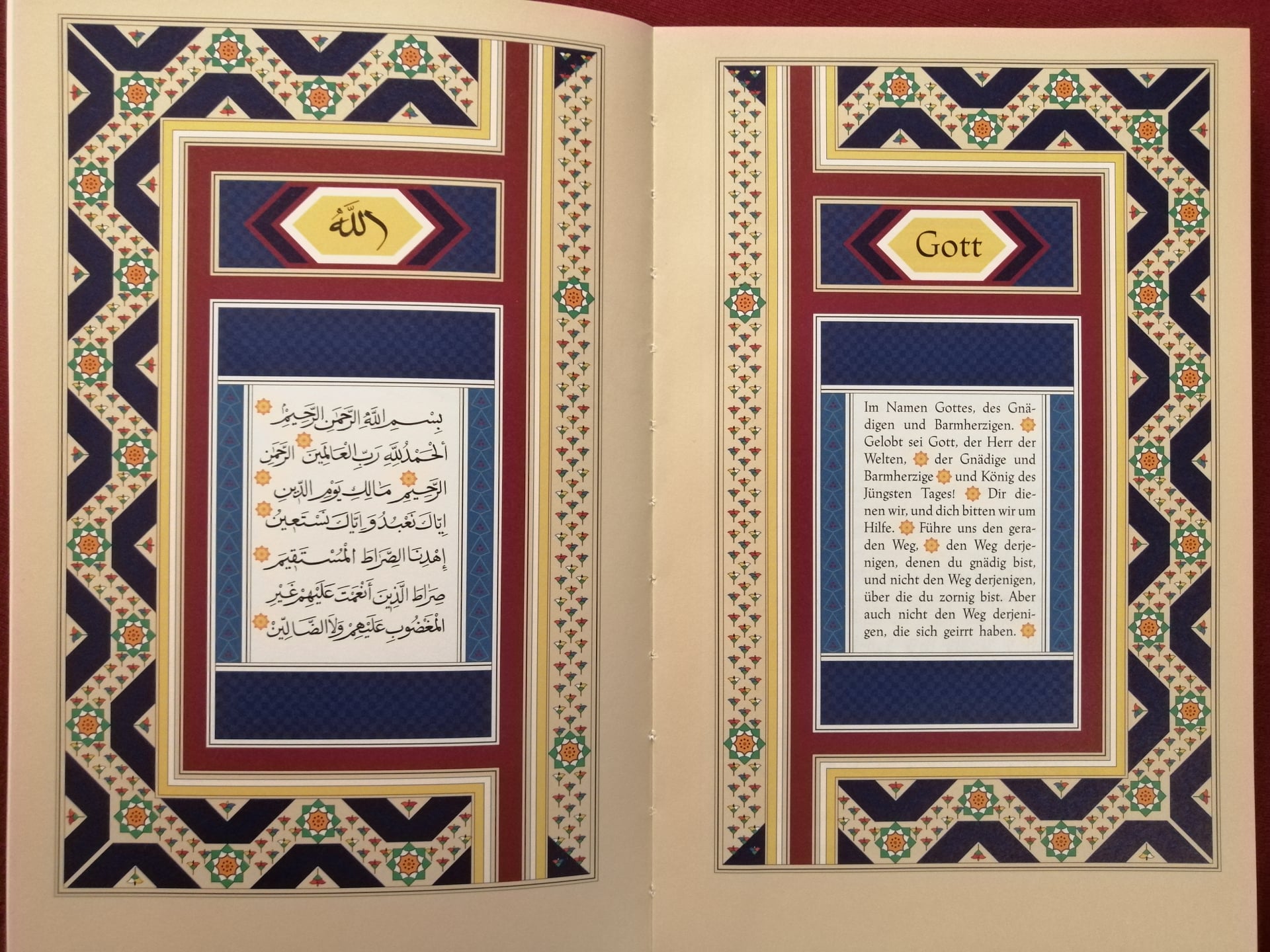Qur’an translations often play a part in familiarizing children with the scripture. Many of them are based on traditional pedagogical approaches, e.g. as a backdrop to teaching the recitation of the shortest surahs in Arabic. In contrast, “The Qur’an for children and adults” (“Der Koran für Kinder und Erwachsene”) by Lamya Kaddor and Rabeya Müller (2008) pursues a thematic approach, aiming for readability and targeting adults as well as children.
Non-Muslims are clearly an important part of the target group: the blurbs on the pocketbook edition exclusively come from the German and Swiss national press; there are no “Muslim credentials”. The targeting of a non-Muslim readership is probably also what enabled the authors to publish this book with one of the largest nonfiction publishers in Germany. Muslims are a minority in German-speaking countries, after all. In Germany, they make up 5-6% of the population. Consequently, the Muslim publishing market that serves mosques and Islamic bookstores is dominated by relatively small and semi-professional publishers, with a focus on traditional, Sufi, and Salafi publications.
Liberal modernist approaches that appeal to non-Muslim readers, besides some Muslims, run the best chance of being published by larger presses outside that niche. The book by Kaddor and Müller is a case in point. Müller (b. 1957) is a convert with a longstanding publishing career in Islamic pedagogy and feminism, while Kaddor (b. 1978) was the co-founder of the Association of Liberal Muslims (Liberal-Islamischer Bund) that promotes an inclusive and egalitarian view of Islam.
Beautifully designed and lavishly illustrated with miniatures from the history of Islamic art, the book starts with the Fatiha and then arranges a selection of Qur’anic verses in 12 thematic chapters, each of which is followed by a short commentary. At first glance, the layout seems quite conventional: the Arabic Qur’an is juxtaposed with the German translation, both in traditional grouped-style layout. However, these are not actually coherent surahs or sections of the Qur’an, but rather compilations of verses.
For example, the section entitled “Who is God?” assembles Q. 20:14, 2:255, 3:18, 3:129, 6:3, 10:55–56, 15:23 and 28:88 in a single paragraph. This struck some Muslim critics as taking too many liberties with the Qur’anic text and its canonical arrangement. It also means that the speaker perspective sometimes changes abruptly, e.g. from talking about God in the 3rd person to God talking in the 1st person: “Er erweckt zum Leben und lässt sterben, und zu ihm werdet ihr zurückgebracht. Nur wir machen tatsächlich lebendig…” (p. 11).
The selection of topics was also criticized. Some Muslim reviewers were missing the prescriptive content of the Qur’an, the Dos and Don’ts; the only legal content in the book is related to worship. Topics such as marriage and inheritance do not occur. Islamophobes blamed the authors for concealing such contentious issues, as well as wife beating, slavery and jihad. Instead, and in line with a pedagogical approach, the focus is on stories of prophets and exemplary women which take up seven of the twelve chapters.
The rest of the chapters are devoted to God, creation, humanity (mostly related to tolerance), worship, and eschatology, eschewing notions of hierarchy between humans and favouring egalitarian, pluralist readings. In the description of Paradise, there are no houris, and the azwāj muṭahhara (Q. 3:15) are translated as “beautiful partners” (“wunderschöne Partner”) rather than the “purified wives” that can be found in some German translations (e.g. Paret, Zirker, Bubenheim/Elyas).
The translation is the authors’ own and quite distinct from previous German Qur’an translations. Müller and Kaddor chose a clear, contemporary, comprehensible style with short clauses. They opted for the German word “Gott” rather than “Allah”, but prefer Arabic names for Biblical personalities such as “Isa, the son of Maryam” – possibly in deference to common Muslim usage.
In their afterword, Müller and Kaddor explicitly state that they sometimes decided to prioritize the meaning of a verse over a literal translation. At the same time, they are quite unconcerned with some widespread theological sensibilities. This is evident when they translate the much contested “ʿalā l-ʿarsh istawā” (Q. 20:5-6) as “Der Barmherzige hat sich auf dem Thron niedergelassen” (“the Merciful has established Himself/sat down on the Throne”). This literal translation assigns to God a physical position in space which is often decried as anthropomorphism. By comparison, Bubenheim/Elyas, whose translation is printed by the Saudi King Fahd Complex, has “is exalted over the Throne” (“ist über dem Thron erhaben”) with a lengthy explanation in the appendix. Muhammad Rassoul has “who rules majestically over His realm” (“Der über Sein Reich majestätisch herrscht”), and Murad Wilfried Hofmann in his edition of Max Henning’s Qur’an translation points out in a footnote that this has to be understood as an allegory.
Kaddor and Müller were obviously less concerned with doctrine than with the beauty of the Qur’an and its stories. As some reviewers have fairly pointed out, this is no different from what many children’s Bibles do. Of course, Kaddor and Müller, or their publisher, have also tried to address adults – this was bound to be a balancing act. The book certainly cannot replace a nuanced discussion of the Qur’an’s meanings and their ethical and theological implications. But then, it was meant to be a first introduction rather than a work of tafsir.
Johanna Pink


